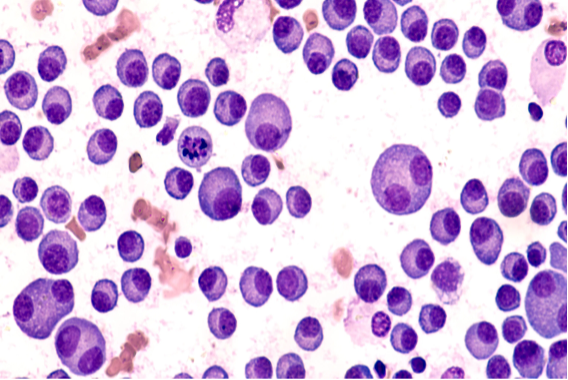Johnson & Johnson Seeks Approval for Darzalex Faspro Combo in Newly Diagnosed Multiple Myeloma
February 2, 2024
Source: drugdu
 424
424
Pharmaceutical Executive Editorial Staff
Darzalex Faspro has previously been approved by the FDA for eight indications in multiple myeloma.
 The FDA will evaluate Johnson & Johnson’s supplemental Biologics License Application (sBLA) for Darzalex Faspro (daratumumab and hyaluronidase-fihj) with bortezomib, lenalidomide, and dexamethasone (D-VRd) for induction and consolidation therapy and in combination with lenalidomide (D-R) for the maintenance treatment of adults newly diagnosed with multiple myeloma who are eligible for autologous stem cell transplant (ASCT).1 Darzalex Faspro, a CD38-directed antibody, has previously been approved by the FDA for eight indications in multiple myeloma, with three in the frontline treatment of newly diagnosed patients who are transplant eligible or ineligible.
The FDA will evaluate Johnson & Johnson’s supplemental Biologics License Application (sBLA) for Darzalex Faspro (daratumumab and hyaluronidase-fihj) with bortezomib, lenalidomide, and dexamethasone (D-VRd) for induction and consolidation therapy and in combination with lenalidomide (D-R) for the maintenance treatment of adults newly diagnosed with multiple myeloma who are eligible for autologous stem cell transplant (ASCT).1 Darzalex Faspro, a CD38-directed antibody, has previously been approved by the FDA for eight indications in multiple myeloma, with three in the frontline treatment of newly diagnosed patients who are transplant eligible or ineligible.
“We are committed to changing the course of multiple myeloma through building combination regimens such as D-VRd with complementary mechanisms of action. The Darzalex Faspro-based quadruplet therapy demonstrated a clinically significant reduction in the risk of progression or death for transplant-eligible, newly diagnosed patients with multiple myeloma,” Craig Tendler, MD, vice president, Clinical Development, Diagnostics, and Global Medical Affairs, Johnson & Johnson Innovative Medicine, said in a press release. “Patients are most likely to experience their deepest and most durable responses during the first line of treatment with D-VRd. This regimen has the potential to improve long-term outcomes for newly diagnosed patients and we look forward to working with the FDA on the review of this application.”
The sBLA submission was based on findings from the ongoing, randomized, open-label Phase III PERSEUS (NCT03710603) trial, which compared D-VRd induction and consolidation therapy, ASCT, and D-R maintenance therapy vs. VRd, ASCT, and lenalidomide maintenance treatment.
For the study, which was published in the New England Journal of Medicine (NEJM), investigators randomly assigned 709 transplant-eligible patients with newly diagnosed multiple myeloma to receive either subcutaneous Darzalex Faspro with VRd induction and consolidation therapy and maintenance treatment with lenalidomide (D-VRd cohort) or VRd induction and consolidation therapy and lenalidomide maintenance monotherapy (VRd cohort). The trial’s primary endpoint was progression-free survival (PFS). Key secondary endpoints were a complete response (CR) or better and minimal residual disease (MRD)–negative status.
Investigators found that at a median follow-up of 47.5 months, patients in the D-VRd cohort had a reduced risk of disease progression or death compared to the VRd cohort. An estimated 84.3% of patients achieved PFS at 48 months in the D-VRd cohort compared with 67.7% in the VRd cohort. Further, 87.9% of patients in the D-VRd cohort achieved a CR or better compared with 70.1% of patients in the VRd cohort.
An estimated 64% of patients administered D-VRd who entered the maintenance phase were able to discontinue Darzalex Faspro after achieving a CR or better and sustained MRD-negativity after at least two years of D-R maintenance.1 In terms of safety, adverse events reported with D-VRd followed by D-R maintenance were consistent with prior findings with Darzalex Faspro, VRd, and R.
“The results of the first interim analysis of the PERSEUS trial, with a median follow-up of 47.5 months, showed that the addition of subcutaneous daratumumab to VRd induction and consolidation therapy and to lenalidomide maintenance therapy conferred a significant benefit with respect to progression-free survival among transplantation-eligible patients with newly diagnosed multiple myeloma,” the authors of the NEJM study wrote. “The risk of disease progression or death in the D-VRd group was significantly lower than the risk in the VRd group. The daratumumab-based therapy also conferred a significant benefit with respect to the depth of response, with a higher overall occurrence of a complete response or better and a higher overall occurrence of MRD-negative status in the D-VRd group than in the VRd group.”
By editorRead more on
- Phase III Clinical Trial of Recombinant Staphylococcus Aureus Vaccine Progressing Normality January 21, 2026
- Its drug marketing application for injectable iza-bren has been accepted January 21, 2026
- Kain Technology withdrew a drug registration application, resulting in a profit reduction of 111 million yuan in 2025 January 21, 2026
- Received Notice of Approval for Drug Clinical Trial January 21, 2026
- Breaking news! AstraZeneca to be delisted from Nasdaq. January 21, 2026
your submission has already been received.
OK
Subscribe
Please enter a valid Email address!
Submit
The most relevant industry news & insight will be sent to you every two weeks.



